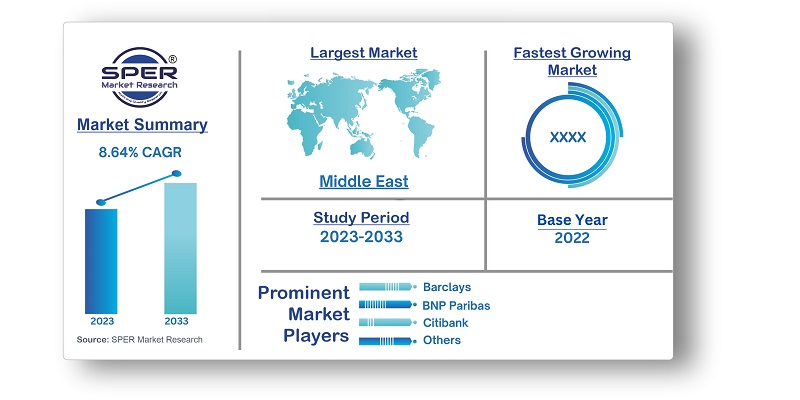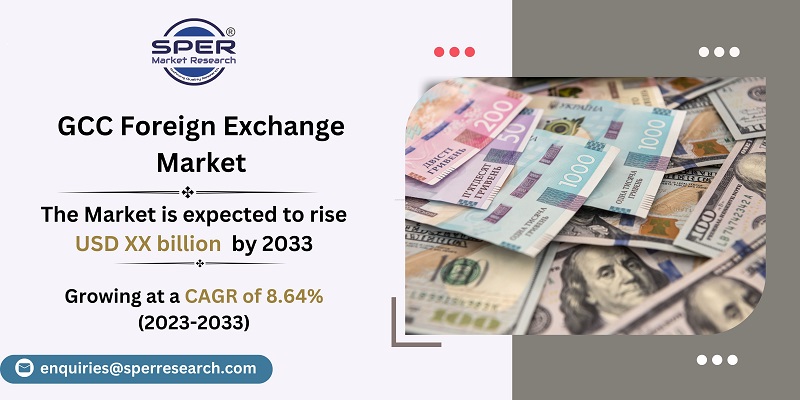
GCC Foreign Exchange Market Growth, Size, Trends, Share, Revenue, Demand and Future Outlook
GCC Foreign Exchange Market Size– By Counterparty, By Type- Regional Outlook, Competitive Strategies and Segment Forecast to 2033
| Published: Jan-2024 | Report ID: BFSI2404 | Pages: 1 - 155 | Formats*: |
| Category : BFSI | |||
- 2008: Following the global crisis, financial regulators within the region started to implement stricter regulations and began to crack down on unregulated entities.


| Report Metric | Details |
| Market size available for years | 2019-2033 |
| Base year considered | 2022 |
| Forecast period | 2023-2033 |
| Segments covered | By Counterparty, By Type |
| Regions covered |
|
| Companies Covered | Barclays, BNP Paribas, Citibank, Deutsche Bank, Goldman Sachs, HSBC Holdings plc., JPMorgan Chase & Co., The Royal Bank of Scotland, UBS AG, Standard Chartered PLC, State Street Corporation, and XTX Markets Limited and various others. |
- Financial institutions
- Multinational Corporations
- Central Banks
- Hedge Funds
- Institutional Investors
- Individual Traders
| By Counterparty: |
|
| By Type: |
|
| By Region: |
|
- GCC Foreign Exchange Market Size (FY’2023-FY’2033)
- Overview of GCC Foreign Exchange Market
- Segmentation of GCC Foreign Exchange Market By Counterparty (Reporting Dealers, Other Financial Institutions, Non-financial Customers)
- Segmentation of GCC Foreign Exchange Market By Type (Currency Swap, Outright Forward and FX Swaps, FX Options)
- Statistical Snap of GCC Foreign Exchange Market
- Expansion Analysis of GCC Foreign Exchange Market
- Problems and Obstacles in GCC Foreign Exchange Market
- Competitive Landscape in the GCC Foreign Exchange Market
- Impact of COVID-19 and Demonetization on GCC Foreign Exchange Market
- Details on Current Investment in GCC Foreign Exchange Market
- Competitive Analysis of GCC Foreign Exchange Market
- Prominent Players in the GCC Foreign Exchange Market
- SWOT Analysis of GCC Foreign Exchange Market
1.1. Scope of the report1.2. Market segment analysis
2.1. Research data source2.1.1. Secondary Data2.1.2. Primary Data2.1.3. SPER’s internal database2.1.4. Premium insight from KOL’s2.2. Market size estimation
2.2.1. Top-down and Bottom-up approach2.3. Data triangulation
4.1. Driver, Restraint, Opportunity and Challenges analysis4.1.1. Drivers4.1.2. Restraints4.1.3. Opportunities4.1.4. Challenges4.2. COVID-19 Impacts of the GCC Foreign Exchange Market
5.1. SWOT Analysis5.1.1. Strengths5.1.2. Weaknesses5.1.3. Opportunities5.1.4. Threats5.2. PESTEL Analysis5.2.1. Political Landscape5.2.2. Economic Landscape5.2.3. Social Landscape5.2.4. Technological Landscape5.2.5. Environmental Landscape5.2.6. Legal Landscape5.3. PORTER’s Five Forces5.3.1. Bargaining power of suppliers5.3.2. Bargaining power of buyers5.3.3. Threat of Substitute5.3.4. Threat of new entrant5.3.5. Competitive rivalry5.4. Heat Map Analysis
6.1. GCC Foreign Exchange Market Manufacturing Base Distribution, Sales Area, Product Type6.2. Mergers & Acquisitions, Partnerships, Product Launch, and Collaboration in GCC Foreign Exchange Market
7.1. GCC Foreign Exchange Market Value Share and Forecast, By Counterparty, 2023-20337.2. Non-financial Customers7.3. Other Financial Institutions7.4. Reporting Dealers
8.1. GCC Foreign Exchange Market Value Share and Forecast, By Type, 2023-20338.2. Currency Swap8.3. FX Options8.4. FX Swaps8.5. Outright Forward
9.1. GCC Foreign Exchange Market Size and Market Share
10.1. GCC Foreign Exchange Market Size and Market Share By Counterparty (2019-2026)10.2. GCC Foreign Exchange Market Size and Market Share By Counterparty (2027-2033)
11.1. GCC Foreign Exchange Market Size and Market Share By Type (2019-2026)11.2. GCC Foreign Exchange Market Size and Market Share By Type (2027-2033)
12.1. GCC Foreign Exchange Market Size and Market Share By Region (2019-2026)12.2. GCC Foreign Exchange Market Size and Market Share By Region (2027-2033)
12.2.1. Bahrain12.2.2. Kuwait12.2.3. Oman12.2.4. Qatar12.2.5. Saudi Arabia12.2.6. UAE12.2.7. Others
13.1. BNP Paribas13.1.1. Company details13.1.2. Financial outlook13.1.3. Product summary13.1.4. Recent developments13.2. Barclays13.2.1. Company details13.2.2. Financial outlook13.2.3. Product summary13.2.4. Recent developments13.3. Citibank13.3.1. Company details13.3.2. Financial outlook13.3.3. Product summary13.3.4. Recent developments13.4. Deutsche Bank13.4.1. Company details13.4.2. Financial outlook13.4.3. Product summary13.4.4. Recent developments13.5. Goldman Sachs13.5.1. Company details13.5.2. Financial outlook13.5.3. Product summary13.5.4. Recent developments13.6. HSBC Holdings plc.13.6.1. Company details13.6.2. Financial outlook13.6.3. Product summary13.6.4. Recent developments13.7. JPMorgan Chase & Co.13.7.1. Company details13.7.2. Financial outlook13.7.3. Product summary13.7.4. Recent developments13.8. Standard Chartered PLC13.8.1. Company details13.8.2. Financial outlook13.8.3. Product summary13.8.4. Recent developments15.20 Others
SPER Market Research’s methodology uses great emphasis on primary research to ensure that the market intelligence insights are up to date, reliable and accurate. Primary interviews are done with players involved in each phase of a supply chain to analyze the market forecasting. The secondary research method is used to help you fully understand how the future markets and the spending patterns look likes.
The report is based on in-depth qualitative and quantitative analysis of the Product Market. The quantitative analysis involves the application of various projection and sampling techniques. The qualitative analysis involves primary interviews, surveys, and vendor briefings. The data gathered as a result of these processes are validated through experts opinion. Our research methodology entails an ideal mixture of primary and secondary initiatives.



Frequently Asked Questions About This Report
PLACE AN ORDER
Year End Discount
Sample Report
Pre-Purchase Inquiry
NEED CUSTOMIZATION?
Request CustomizationCALL OR EMAIL US
100% Secure Payment






Related Reports
Our Global Clients
Our data-driven insights have influenced the strategy of 200+ reputed companies across the globe.




















